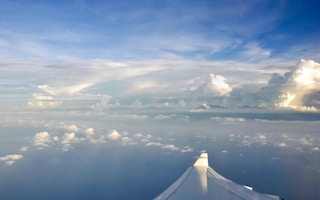If you are used to spending a long time flying the Atlantic between Europe and North America, be warned: you’ll have to be prepared soon to spend significantly longer − thanks to the warming atmosphere.
Aircraft flying the crowded and lucrative routes linking Europe to Canada and the US will be spending longer in the air on the westward leg, but not when heading east. And what happens in that stretch of sky is liable to happen in other parts of the world as well.
A study published in Environmental Research Letters says the cause is the acceleration of the jet stream, a high-altitude wind that blows from west to east across the Atlantic.
As that gets faster, climate change will speed up eastbound flights, but slow down those heading the other way, the study found. This could affect airlines, airports and passengers.
The study, led by Dr Paul Williams, an atmospheric scientist at the University of Reading, UK, calculates that transatlantic aircraft will collectively spend an extra 2,000 hours in the air every year, adding millions of dollars to airline fuel costs and increasing the risk of delays.
Environmental impacts
“The aviation industry is facing pressure to reduce its environmental impacts, but this study shows a new way in which aviation is itself susceptible to the effects of climate change,” Dr Williams says.
“The bad news for passengers is that westbound flights will be battling against stronger headwinds. The good news is that eastbound flights will be boosted by stronger tailwinds, but not enough to compensate for the longer westbound journeys. The net result is that roundtrip journeys will significantly lengthen.
“
This effect will increase the fuel costs to airlines, potentially raising ticket prices, and it will worsen the environmental impacts of aviation.
Dr Paul Williams, atmospheric scientist, University of Reading
“This effect will increase the fuel costs to airlines, potentially raising ticket prices, and it will worsen the environmental impacts of aviation.”
Impacts identified in the study include increased take-off weight restrictions, and intensified turbulence during flights.
The study examined the effects of doubling the amount of CO2 in the atmosphere, which it says will occur within the next few decades unless emissions are cut quickly.
The average jet-stream winds along the flight route between London’s Heathrow and New York’s John F. Kennedy International airport are predicted to become 15 per cent faster in winter, increasing from 77 to 89 km/hr (48 to 55 mph), with similar increases in the other seasons.
As a result, London-bound flights will become twice as likely to take under 5 hours 20 minutes, implying that record-breaking crossings will happen increasingly often. But the study says New York-bound flights will become twice as likely to take longer than 7 hours, suggesting more delayed arrivals in prospect.
The current record for a transatlantic crossing from New York to London − excluding flights by the supersonic Concorde aircraft − stands at 5 hours 16 minutes. It was set on 8 January 2015 by a British Airways 777, helped by a particularly strong eastbound jet stream.
Annual emissions
The extra time spent in the air means transatlantic flights will together burn an extra US$22 million-worth of fuel annually, and will emit an extra 70 million kg of CO2 – equivalent to the annual emissions of 7,100 UK homes. And this might be only the start.
Dr Williams says: “The jet stream encircles the globe, and there is one in the southern hemisphere too. It is possible that flights elsewhere in the world will also suffer from a similar jet stream effect.”
A previous University of Reading study led by Dr Williams found that clear-air turbulence will become stronger and more frequent as a result of global warming.
The route between Europe and North America is one of the world’s busiest aviation corridors, with around 600 flights per day – out of an estimated 100,000 flights per day globally. Historically, global air traffic (measured in passenger-kilometres) has experienced an average long-term growth rate of 5 per cent per year.

















